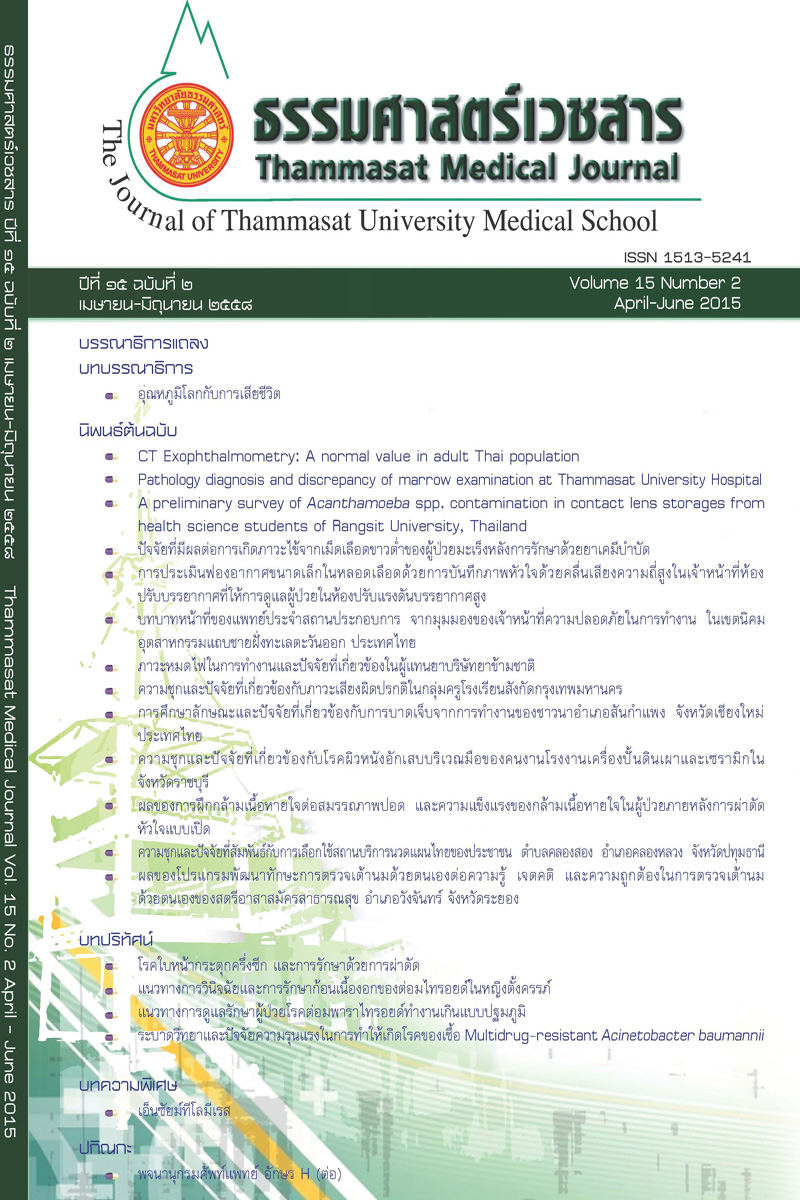Potential risk factors of febrile neutropenia in cancer patients receiving chemotherapy
Keywords:
ภาวะไข้จากเม็ดเลือดขาวต่ำ, เม็ดเลือดขาวชนิดนิวโตรฟิลล์ต่ำ, การติดเชื้อ, Febrile neutropenia, Neutropenia, InfectionAbstract
Introduction: Febrile neutropenia is a common condition that occurs after chemotherapy. This situation consumes a lot of human and non-human resources. There are many predictive models for this situation, but these complications were still occurred. Objective of this study was to demonstrate the incidence, mortality rate and factors that increased incidence of febrile neutropenia in post-chemotherapeutic patients in medicine department at Thammasat University Hospital.
Method: This was a retrospective study reviewed 2 years data of patients who had febrile neutropenia after receiving chemotherapy from January 1, 2012 to December 31, 2013.
Result: There were 65 patients diagnosed with cancer and receiving chemotherapy (male 32 cases, female 33 cases) during that period. Total episode of chemotherapy were 260 and febrile neutropenia occurred in 45 episodes. The incidence of febrile neutropenia was 17.30%. The highest incidence of febrile neutropenia was in acute myeloblastic leukemia (AML) (42.85%), the second was acute lymphoblastic leukemia (ALL) (35.71%) and primary central nervous system lymphoma (PCNSL) (14.28%). Febrile neutropenia in Non-Hodgkin lymphoma found 12.28% and lung cancer 1.96% respectively. There was no febrile neutropenia found in Hodgkin lymphoma and multiple myeloma patients. For all febrile neutropenia patients, AML had the highest mortality rate (46.15%). The most common source of infection was pneumonia, 18 episodes (40%), and the second was septicemia, 15 episodes (33.33%), all with hemoculture positive. The major organisms were gram-negative bacilli and the most common organisms were E. coli (6), Pseudomonas aeruginosa (4), Klebseilla spp. (4) and Acinetobactor spp. (4). There was increase incidence of fungal infection with the highest fungal infection identified as pulmonary aspergillosis (7).
Discussion and Conclusion: The incidence of febrile neutropenia at Thammasat hospital was 17.30%. Compare with the previous study, gram-negative bacilli organism were still the most common cause of febrile neutropenia. However there were increase incidence of fungal infection in this may be due to prolong course of antibiotic use. The history of febrile neutropenia was associated with increase incidence of febrile neutropenia. (p-value < 0.05) The use of G-CSF was not associated with decrease of death rate and the shorter duration of febrile neutropenia.
Key words: Febrile neutropenia, Neutropenia, Infection
ปัจจัยที่มีผลต่อการเกิดภาวะไข้จากเม็ดเลือดขาวต่ำของผู้ป่วยมะเร็งหลังการรักษาด้วยยาเคมีบำบัด
ปิยะวดี เทพรัตน์, นงลักษณ์ คณิตทรัพย์
ภาควิชาอายุรศาสตร์ คณะแพทยศาสตร์ มหาวิทยาลัยธรรมศาสตร์
บทคัดย่อ
บทนำ: ภาวะไข้จากเม็ดเลือดขาวต่ำภายหลังการได้รับยาเคมีบำบัด นำมาซึ่งการสูญเสียทรัพยากรทางสาธารณสุขเป็นอย่างมาก ปัจจุบันมีวิธีการทำนายโอกาสการเกิดภาวะดังกล่าว หลายอย่าง แต่ยังพบว่ามีการเกิดภาวะไข้จากเม็ดเลือดขาวต่ำอยู่เสมอ วัตถุประสงค์ของการวิจัยเพื่อศึกษาอุบัติการณ์ อัตราการเสียชีวิต และปัจจัยที่มีผลต่อการเกิดภาวะไข้จากเม็ดเลือดขาวตำ ในผู้ป่วยโรคมะเร็งภายหลังการได้รับยาเคมีบำบัดในแผนกอายุรกรรม โรงพยาบาลธรรมศาสตร์เฉลิมพระเกียรติ
วิธีการศึกษา: ศึกษาแบบเก็บข้อมูลย้อนหลังของผู้ป่วยที่มีภาวะไข้จากเม็ดเลือดขาวตำ่ หลังการได้รับยาเคมีบำบัด โดยเก็บข้อมูลย้อนหลัง ๒ ปี ตั้งแต่ ๑ มกราคม พ.ศ. ๒๕๕๕ ถึง ๓๑ ธันวาคม พ.ศ. ๒๕๕๖
ผลการศึกษา: พบผู้ป่วยโรคมะเร็งที่ได้รับยาเคมีบำบัดทั้งหมด ๖๕ ราย (เพศชาย ๓๒ ราย เพศหญิง ๓๓ ราย) จำนวน ๒๖๐ ครั้ง เกิดภาวะไข้จากเม็ดเลือดขาวต่ำ ๔๕ ครั้ง คิดเป็นร้อยละ ๑๗.๓๐ โดยผู้ป่วยที่เกิดภาวะไข้จากเม็ดเลือดขาวต่ำมากที่สุด ได้แก่ ผู้ป่วยมะเร็งเม็ดเลือดขาวชนิด Acute Myeloblastic Leukemia (AML) ร้อยละ ๔๒.๘๕ อันดับที่สองคือ มะเร็งเม็ดเลือดขาวชนิด Acute Lymphoblastic Leukemia (ALL) ร้อยละ ๓๕.๗๑ อันดับที่สามคือ มะเร็งต่อมน้ำเหลืองชนิดประสาทส่วนกลาง (primary central nervous system lymphoma: PCNSL) (ร้อยละ ๑๔.๒๘) มะเร็งต่อมนเหลืองชนิด Non-Hodgkin lymphoma (NHL) (ร้อยละ ๑๒.๒๘) และมะเร็งปอด(ร้อยละ ๑.๙๖) ไม่พบภาวะไข้จากเม็ดเลือดขาวตำในผู้ป่วยมะเร็งต่อมนำเหลือง Hodgkin lymphoma (HL) และมะเร็ง Multiple myeloma (MM) การศึกษานี้พบว่า มีผู้ป่วย AML เสียชีวิตจากภาวะดังกล่าวมากที่สุด (ร้อยละ ๔๖.๑๕) ตำแหน่งติดเชื้อที่พบมากสุดคือ การติดเชื้อปอดอักเสบ (Pneumonia) ๑๘ ครั้ง (ร้อยละ ๔๐) รองลงมาคือ การติดเชื้อในกระแสเลือด (Septicemia) ๑๕ ครั้ง (ร้อยละ ๓๓.๓๓) เชื้อแบคทีเรียที่พบส่วนมากเป็นเชื้อแบคทีเรียชนิดแกรมลบ ซึ่งเชื้อที่พบมากคือ E. coli (๖ ครั้ง) Pseudomonas aeruginosa (๔ ครั้ง) Klebsiella spp. (๔ ครั้ง) และ Acinetobactor spp. (๔ ครั้ง) และพบว่ามีอุบัติการณ์การติดเชื้อรามากขึ้น โดยพบการติดเชื้อราในปอดชนิดรุกราน (Invasive aspergillosis) มากถึง ๗ ครั้ง
วิจารณ์ และสรุปผลการศึกษา: พบอุบัติการณ์ของไข้จากเม็ดเลือดขาวต่ำในผู้ป่วยโรคมะเร็งที่โรงพยาบาลธรรมศาสตร์เฉลิมพระเกียรติร้อยละ ๑๗.๓๐ เมื่อเทียบกับการศึกษาจากสถาบันเดียวกันก่อนหน้านี้ เชื้อแบคทีเรียที่พบส่วนมากเป็นเชื้อแบคทีเรียชนิดแกรมลบเช่นเดิมแต่อุบัติการณ์การติดเชื้อราเพิ่มมากขึ้น อาจเนื่องจากมีการใช้ยาปฏิชีวนะที่เพิ่มขึ้นในการศึกษานี้การใช้ยา G-CSF ไม่ได้ลดอัตราการตาย และไม่ลดระยะเวลาการเกิดไข้จากภาวะเม็ดเลือดขาวต่ำ ประวัติการเคยเกิดไข้จากเม็ดเลือดขาวต่ำมาก่อน มีความสัมพันธ์กับการเกิดภาวะไข้จากเม็ดเลือดขาวต่ำที่เพิ่มขึ้นอย่างมีนัยสำคัญทางสถิติ (p-value < ๐.๐๕)
คำสำคัญ: ภาวะไข้จากเม็ดเลือดขาวต่ำ, เม็ดเลือดขาวชนิดนิวโตรฟิลล์ต่ำ, การติดเชื้อ


